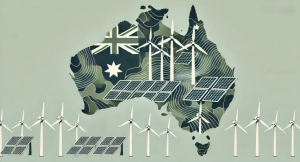Australia has long been at the forefront of innovation, and investments in renewable energy present an immense opportunity for the country’s future. As the global demand for cleaner energy solutions rises, Australia is uniquely positioned to harness its natural resources to lead in this sector.
Renewable energy, including solar, wind, and hydroelectric power, can offer sustainable alternatives to traditional fossil fuels, creating not only environmental benefits but also economic opportunities. In this article, we’ll explore why investing in renewables in Australia is a smart move, discussing the current landscape, the challenges, and the promising pathways ahead for clean energy initiatives.
Australia’s renewable energy landscape

The state of renewable energy in Australia has evolved significantly over the past few decades. Initially met with skepticism, green energy sources have since gained widespread acceptance and integration into the power grid. Solar power, in particular, has seen exponential growth, with photovoltaic installations becoming increasingly common across households and industries.
As of 2023, Australia ranks among the top nations globally in terms of solar energy output, providing a strong indicator of the sector’s potential. Wind energy has also made significant strides, contributing substantially to the national energy mix and aiding in the reduction of carbon emissions.
Despite this progress, challenges remain in achieving a fully renewable energy system. Integrating diverse energy sources and improving storage capabilities are critical areas that require continuous investment and innovation. Further, regional power disparities necessitate a more uniform approach to ensure that all areas, including remote and rural communities, benefit equally from advancements in sustainable energy.
Looking ahead, Australia’s renewable energy landscape presents promising opportunities for economic growth and development. With continued investment and focus on technological innovation, the sector is well-positioned to overcome existing hurdles. Moreover, increased collaboration between the public and private sectors can expedite the deployment of renewables across the country.
Government policies driving green energy
The Australian government has enacted several policies aimed at promoting the adoption and expansion of renewable energy technologies. Initiatives such as the Renewable Energy Target (RET) have been instrumental in encouraging investment in clean power projects. These policies aim to increase the share of renewables in the national energy mix, reducing reliance on coal and other non-renewable sources.
By offering incentives and subsidies to both individuals and businesses, the government has made it economically feasible to adopt sustainable energy solutions. These measures have empowered a wide range of stakeholders to invest in solar panels, wind farms, and other renewable infrastructure. Furthermore, national and state-level energy plans emphasize the importance of modernizing the energy grid to better accommodate and distribute renewable power.
Importantly, these policies align with international commitments to reduce greenhouse gas emissions and combat climate change. By integrating sustainable practices into national policy, Australia sets a standard that encourages other nations to follow suit. This leadership not only enhances the country’s global standing but also cultivates a healthier environment for future generations.
Challenges and innovations in the sector
While the growth of renewable energy in Australia is promising, it comes with its own set of challenges. One major hurdle is ensuring grid stability, as renewable sources like solar and wind are inherently variable and dependent on weather conditions. Addressing this requires significant advancements in energy storage technology, such as batteries that can store excess power and release it during periods of low generation.
Another challenge lies in scaling up infrastructure rapidly to meet the rising demand for clean energy. Building new facilities, especially in remote areas, often involves navigating complex regulatory landscapes and securing substantial upfront investment. Innovations in smart grid technology offer solutions by improving efficiency and optimizing the distribution of renewable energy.
Furthermore, fostering a skilled workforce to support and maintain renewable energy systems remains a priority. Educational institutions and industry partnerships are crucial in training a new generation of technicians and engineers equipped to drive the sector forward. With a continued emphasis on research and innovation, Australia can overcome these challenges, ensuring that the expansion of renewable energy systems is both sustainable and economically beneficial.
Opportunities for investors
The burgeoning renewable energy sector in Australia presents a myriad of opportunities for investors looking to make an impact both environmentally and financially. As the nation progresses towards a more sustainable energy model, numerous investment avenues have emerged. Renewable energy projects often promise attractive returns due to cost declines in technology and growing consumer demand for clean power.
Venture capitalists and institutional investors alike are capitalizing on these opportunities by funding solar farms, wind projects, and emerging technologies in energy storage. The rising interest in eco-friendly investments extends beyond national borders, attracting global capital that sees the potential in Australia’s natural resources. Furthermore, sectors such as energy efficiency, electric vehicles, and innovative energy solutions represent expansive fields ripe for investment.
By participating in Australia’s renewable energy transformation, investors can play a crucial role in shaping a sustainable future. The combination of technological advancements, policy support, and a strong natural resource base makes Australia a prime location for renewable energy investments.



